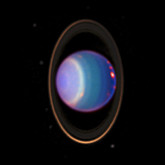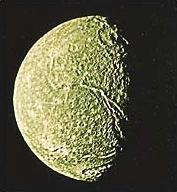|
Features
- Appearance: A hazy, blue-green
disk from methane clouds (although the atmosphere is mostly H
and He); The oddball among
jovian planets, does not produce much internal heat (is the core
too well insulated?), and it is not heated by the Sun as much as
Saturn, so the atmosphere keeps the temperature almost uniform, and
Uranus has few distinct cloud
features or storms.
- Rotation: Differential (faster
at the poles), 17.2 hrs, tilted about 98° (from a catastrophic
impact billions of years ago?); More sunlight at the poles!
- Interior: Small core; In general,
a mixture of rocky fragments and various ices (water, methane,
ammonia).
|
 |

_215x175.jpg)

_215x175.jpg)
_254x332.jpg)


![]()